

College Students on Critical Thinking in the Classroom. According to our recent “Student Engagement Insights” survey of over three thousand college students, 99% of students believe critical thinking is an important skill for them to learn in the classroom.
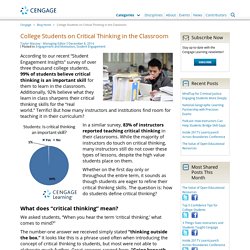
Additionally, 92% believe what they learn in class sharpens their critical thinking skills for the “real world.” Terrific! But how many instructors and institutions find room for teaching it in their curriculum? Becoming a Critic Of Your Thinking. Learning the Art of Critical Thinking There is nothing more practical than sound thinking.

No matter what your circumstance or goals, no matter where you are, or what problems you face, you are better off if your thinking is skilled. As a manager, leader, employee, citizen, lover, friend, parent---in every realm and situation of your life, good thinking pays off. Critical Thinking Skills: What are They and How Do I Get Them? - Thinker Academy. Critical thinking is often touted as a superior way to confront the issues one faces.
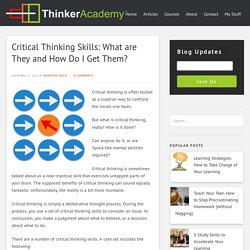
But what is critical thinking, really? How is it done? Can anyone do it, or are Spock-like mental abilities required? Critical thinking is sometimes talked about as a near-mystical skill that exercises untapped parts of your brain. Teaching Critical Thinking: Some Practical Points. We all endorse it and we all want our students to do it.
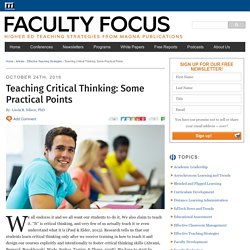
We also claim to teach it. “It” is critical thinking, and very few of us actually teach it or even understand what it is (Paul & Elder, 2013). Research tells us that our students learn critical thinking only after we receive training in how to teach it and design our courses explicitly and intentionally to foster critical thinking skills (Abrami, Bernard, Borokhovski, Wade, Surkes, Tamim, & Zhang, 2008).
We have to start by formulating assessable critical thinking learning outcomes and building our courses around them. Teaching Critical Thinking: Some Practical Points. Skills for the 21st Century: teaching higher-order thinking. This article originally appeared in the April 2014 edition of ISQ Briefings, a publication of Independent Schools Queensland.
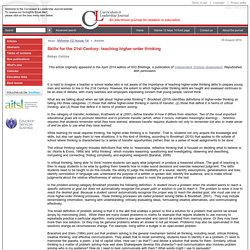
Republished with permission. It is hard to imagine a teacher or school leader who is not aware of the importance of teaching higher-order thinking skills to prepare young men and women to live in the 21st Century. However, the extent to which higher-order thinking skills are taught and assessed continues to be an area of debate, with many teachers and employers expressing concern that young people ‘cannot think’. Skills for the 21st Century: teaching higher-order thinking. This article originally appeared in the April 2014 edition of ISQ Briefings, a publication of Independent Schools Queensland.

Republished with permission. Skills for the 21st Century: teaching higher-order thinking. Skills for the 21st Century: teaching higher-order thinking. Examples of Activities that Promote Higher Order Thinking. Examples of Activities: Science Apply a Rule: The student could be asked to explain why a shotgun "kicks" when fired.
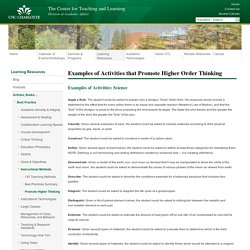
His response would include a statement to the effect that for every action there is an equal and opposite reaction (Newton's Law of Motion), and that the "kick" of the shotgun is equal to the force propelling the shot toward its target. The faster the shot travels and the greater the weight of the shot, the greater the "kick" of the gun. Classify: Given several examples of each, the student could be asked to classify materials according to their physical properties as gas, liquid, or solid. Construct: The student could be asked to construct a model of a carbon atom. Define: Given several types of plant leaves, the student could be asked to define at least three categories for classifying them. Describe: The student could be asked to describe the conditions essential for a balanced aquarium that includes four goldfish. How to Encourage More Creative Thinking. Have you ever wished you were more creative?
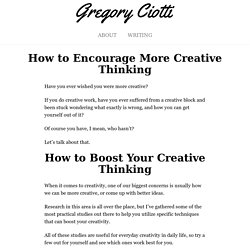
If you do creative work, have you ever suffered from a creative block and been stuck wondering what exactly is wrong, and how you can get yourself out of it? Of course you have, I mean, who hasn’t? Let’s talk about that. How to Boost Your Creative Thinking When it comes to creativity, one of our biggest concerns is usually how we can be more creative, or come up with better ideas. Research in this area is all over the place, but I’ve gathered some of the most practical studies out there to help you utilize specific techniques that can boost your creativity. All of these studies are useful for everyday creativity in daily life, so try a few out for yourself and see which ones work best for you. 1.) Later on I will show you how external restrictions can hurt creativity, but right now I’m talking about internal restrictions, which can actually be used to boost creativity!
Overcoming the Digital Dilemma: Developing and Measuring Critical Thinking Gained through Cocurricular Experiences in a Time of Information Overload - Summer 2014: The Journal of Technology in Student Affairs presented by StudentAffairs.com. Overcoming the Digital Dilemma: Developing and Measuring Critical Thinking Gained through Cocurricular Experiences in a Time of Information Overload Adam E.

Peck, Ph.D. Assistant Vice President and Dean of Student Affairs Stephen F. Austin State Universitypeckae@sfasu.edu According to the website, InternetLiveStats.com, Google now processes over 40,000 search queries every second, conducting over 3.5 billion searches per day and 1.2 trillion searches per year worldwide ("Google Search Statistics,” 2014).
And while this vast quantity of often conflicting information should make students less confident in what they know and believe, it seems too often to have the opposite effect. This constitutes the sort of “digital dilemma” referenced in the title of this piece. Throughout the past twenty years, educators have placed an increasing emphasis on the concept of critical thinking as a means for helping students to evaluate the information they receive. References Hendrickson, N., St. King, P.